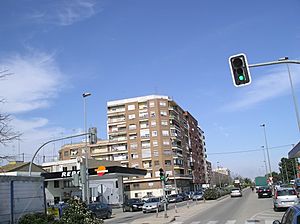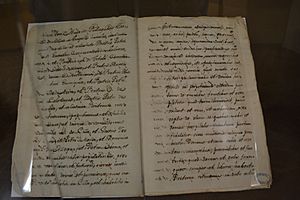Silla, Spain facts for kids
Quick facts for kids
Silla
|
|||
|---|---|---|---|
 |
|||
|
|||
| Country | |||
| Autonomous community | |||
| Province | Valencia | ||
| Comarca | Horta Sud | ||
| Judicial district | Carlet | ||
| Area | |||
| • Total | 25 km2 (10 sq mi) | ||
| Elevation | 8 m (26 ft) | ||
| Population
(2018)
|
|||
| • Total | 18,467 | ||
| • Density | 739/km2 (1,910/sq mi) | ||
| Demonym(s) | Siller, Sillera | ||
| Time zone | UTC+1 (CET) | ||
| • Summer (DST) | UTC+2 (CEST) | ||
| Postal code |
46460
|
||
| Official language(s) | Valencian and Spanish | ||
Silla (pronounced 'si-lya') is a lively town in Spain. It's located in the Valencian Community, a region on the eastern coast. Silla is part of a smaller area called Horta Sud. In 2014, about 18,644 people lived there.
Silla is known for its cultural activities. It has several casales falleros, which are clubs for the famous Fallas festival. This festival is a big celebration with huge sculptures that are later burned. The town also has many other cultural groups. Because many people from Andalusia moved to Silla in the 1960s, there's even a special "Casa de Andalucia" (House of Andalusia) that celebrates their culture.
The town is also home to an important local theater school. It was started in 1985 and was one of the first drama schools in the area.
What's in a Name?
The exact meaning of the name "Silla" is a bit of a mystery! There are a few ideas about where it comes from:
- Some people think it comes from the Arabic word Sila.
- Others believe it comes from Latin.
- A third idea is that it comes from the Valencian word for "the island."
The most popular idea is that the name comes from Latin. This is because we know there was a Roman "cellar" (a place for storing things, often wine) where Silla is now. This suggests a Roman connection to the town's past.
Famous People from Silla
Silla has been home to some notable individuals:
- Juan María de la Cruz (1891-1936): He was a priest who lived in Silla.
- Javi Moreno (born 1974): He is a well-known former professional footballer.
See also

- In Spanish: Silla (Valencia) para niños





